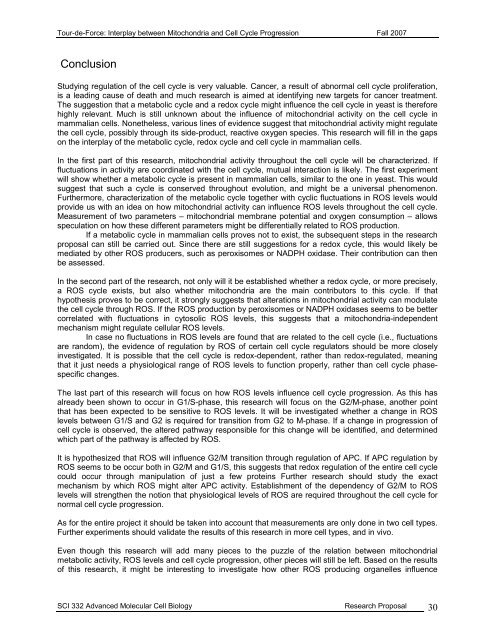Tour-de-Force
Tour-de-Force
Tour-de-Force
You also want an ePaper? Increase the reach of your titles
YUMPU automatically turns print PDFs into web optimized ePapers that Google loves.
<strong>Tour</strong>-<strong>de</strong>-<strong>Force</strong>: Interplay between Mitochondria and Cell Cycle Progression Fall 2007ConclusionStudying regulation of the cell cycle is very valuable. Cancer, a result of abnormal cell cycle proliferation,is a leading cause of <strong>de</strong>ath and much research is aimed at i<strong>de</strong>ntifying new targets for cancer treatment.The suggestion that a metabolic cycle and a redox cycle might influence the cell cycle in yeast is thereforehighly relevant. Much is still unknown about the influence of mitochondrial activity on the cell cycle inmammalian cells. Nonetheless, various lines of evi<strong>de</strong>nce suggest that mitochondrial activity might regulatethe cell cycle, possibly through its si<strong>de</strong>-product, reactive oxygen species. This research will fill in the gapson the interplay of the metabolic cycle, redox cycle and cell cycle in mammalian cells.In the first part of this research, mitochondrial activity throughout the cell cycle will be characterized. Iffluctuations in activity are coordinated with the cell cycle, mutual interaction is likely. The first experimentwill show whether a metabolic cycle is present in mammalian cells, similar to the one in yeast. This wouldsuggest that such a cycle is conserved throughout evolution, and might be a universal phenomenon.Furthermore, characterization of the metabolic cycle together with cyclic fluctuations in ROS levels wouldprovi<strong>de</strong> us with an i<strong>de</strong>a on how mitochondrial activity can influence ROS levels throughout the cell cycle.Measurement of two parameters – mitochondrial membrane potential and oxygen consumption – allowsspeculation on how these different parameters might be differentially related to ROS production.If a metabolic cycle in mammalian cells proves not to exist, the subsequent steps in the researchproposal can still be carried out. Since there are still suggestions for a redox cycle, this would likely bemediated by other ROS producers, such as peroxisomes or NADPH oxidase. Their contribution can thenbe assessed.In the second part of the research, not only will it be established whether a redox cycle, or more precisely,a ROS cycle exists, but also whether mitochondria are the main contributors to this cycle. If thathypothesis proves to be correct, it strongly suggests that alterations in mitochondrial activity can modulatethe cell cycle through ROS. If the ROS production by peroxisomes or NADPH oxidases seems to be bettercorrelated with fluctuations in cytosolic ROS levels, this suggests that a mitochondria-in<strong>de</strong>pen<strong>de</strong>ntmechanism might regulate cellular ROS levels.In case no fluctuations in ROS levels are found that are related to the cell cycle (i.e., fluctuationsare random), the evi<strong>de</strong>nce of regulation by ROS of certain cell cycle regulators should be more closelyinvestigated. It is possible that the cell cycle is redox-<strong>de</strong>pen<strong>de</strong>nt, rather than redox-regulated, meaningthat it just needs a physiological range of ROS levels to function properly, rather than cell cycle phasespecificchanges.The last part of this research will focus on how ROS levels influence cell cycle progression. As this hasalready been shown to occur in G1/S-phase, this research will focus on the G2/M-phase, another pointthat has been expected to be sensitive to ROS levels. It will be investigated whether a change in ROSlevels between G1/S and G2 is required for transition from G2 to M-phase. If a change in progression ofcell cycle is observed, the altered pathway responsible for this change will be i<strong>de</strong>ntified, and <strong>de</strong>terminedwhich part of the pathway is affected by ROS.It is hypothesized that ROS will influence G2/M transition through regulation of APC. If APC regulation byROS seems to be occur both in G2/M and G1/S, this suggests that redox regulation of the entire cell cyclecould occur through manipulation of just a few proteins Further research should study the exactmechanism by which ROS might alter APC activity. Establishment of the <strong>de</strong>pen<strong>de</strong>ncy of G2/M to ROSlevels will strengthen the notion that physiological levels of ROS are required throughout the cell cycle fornormal cell cycle progression.As for the entire project it should be taken into account that measurements are only done in two cell types.Further experiments should validate the results of this research in more cell types, and in vivo.Even though this research will add many pieces to the puzzle of the relation between mitochondrialmetabolic activity, ROS levels and cell cycle progression, other pieces will still be left. Based on the resultsof this research, it might be interesting to investigate how other ROS producing organelles influenceSCI 332 Advanced Molecular Cell Biology Research Proposal 30
















